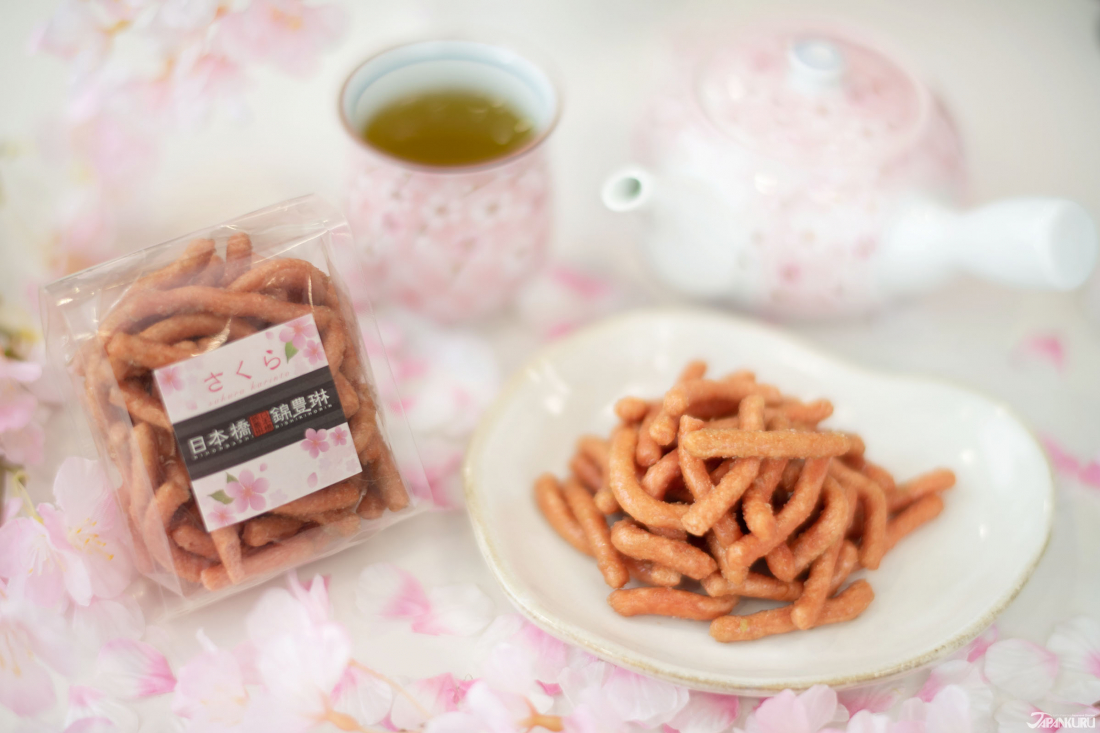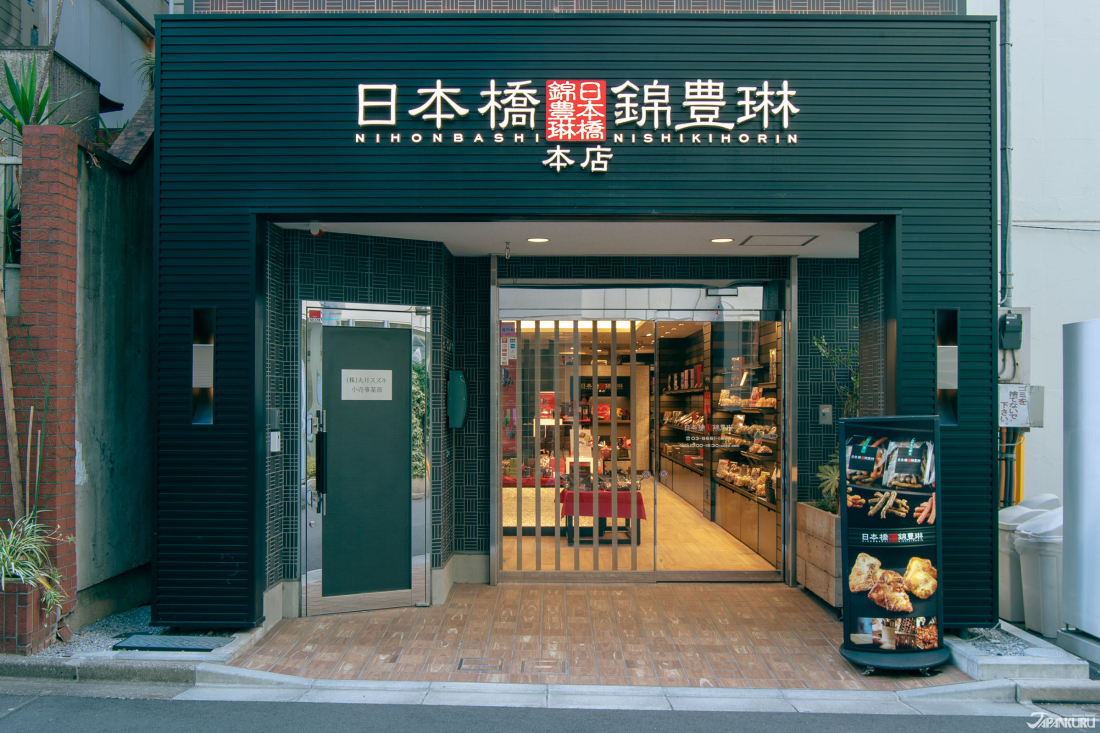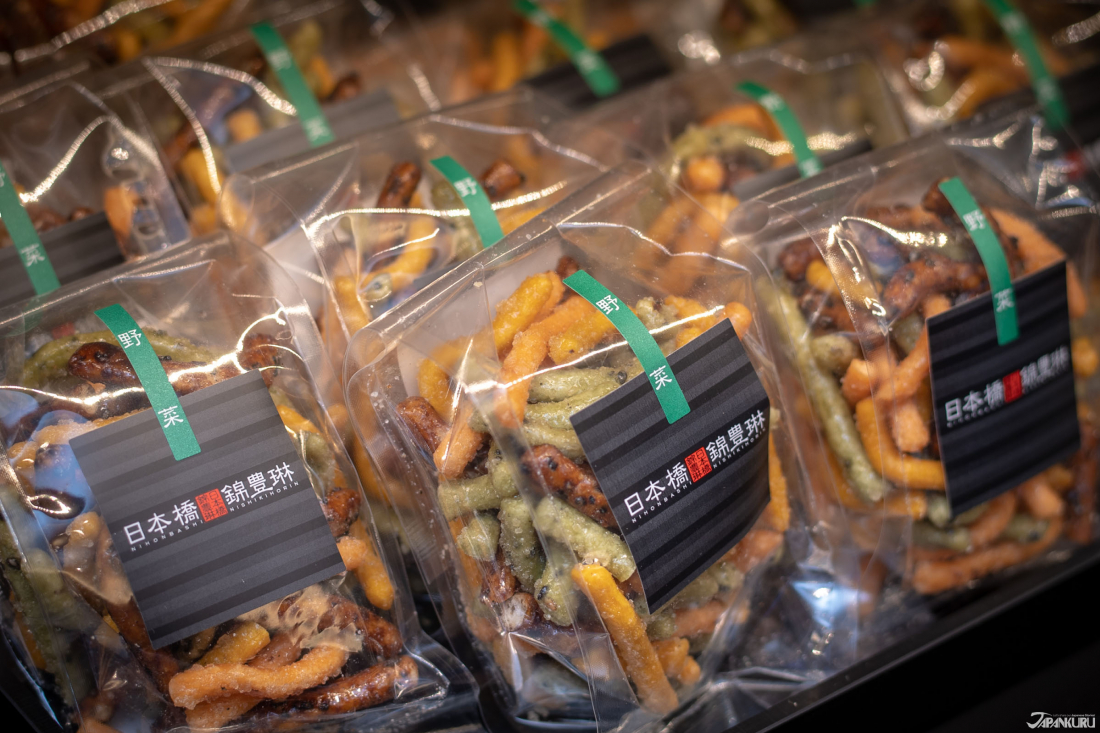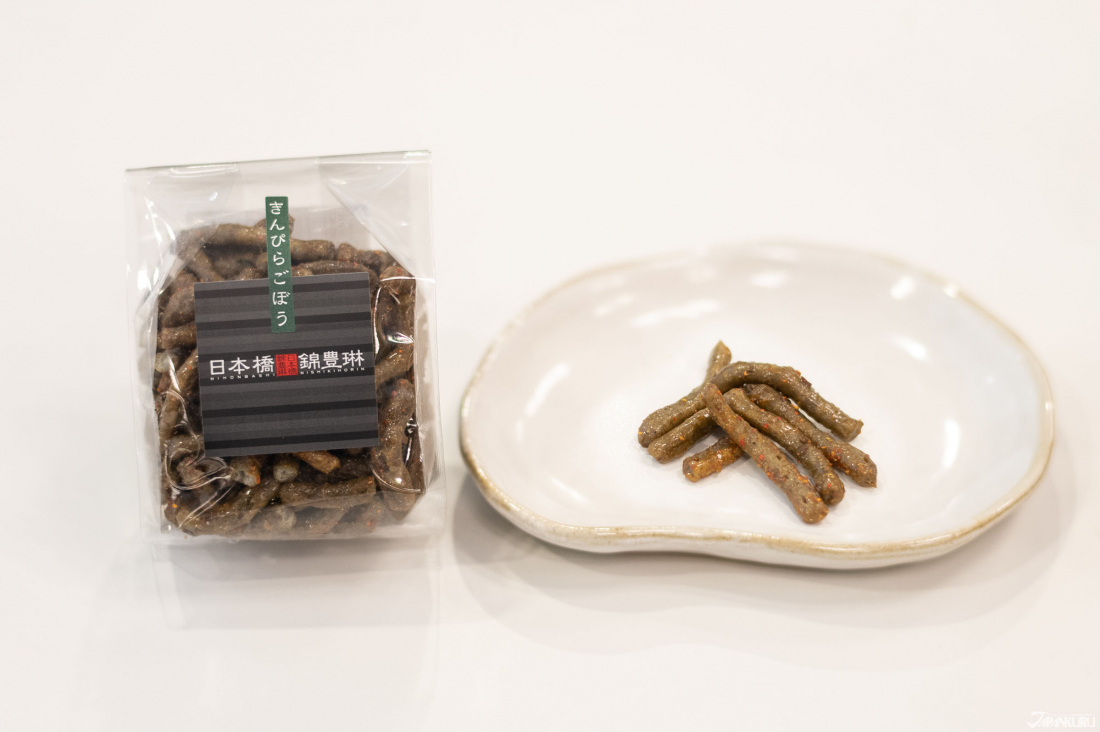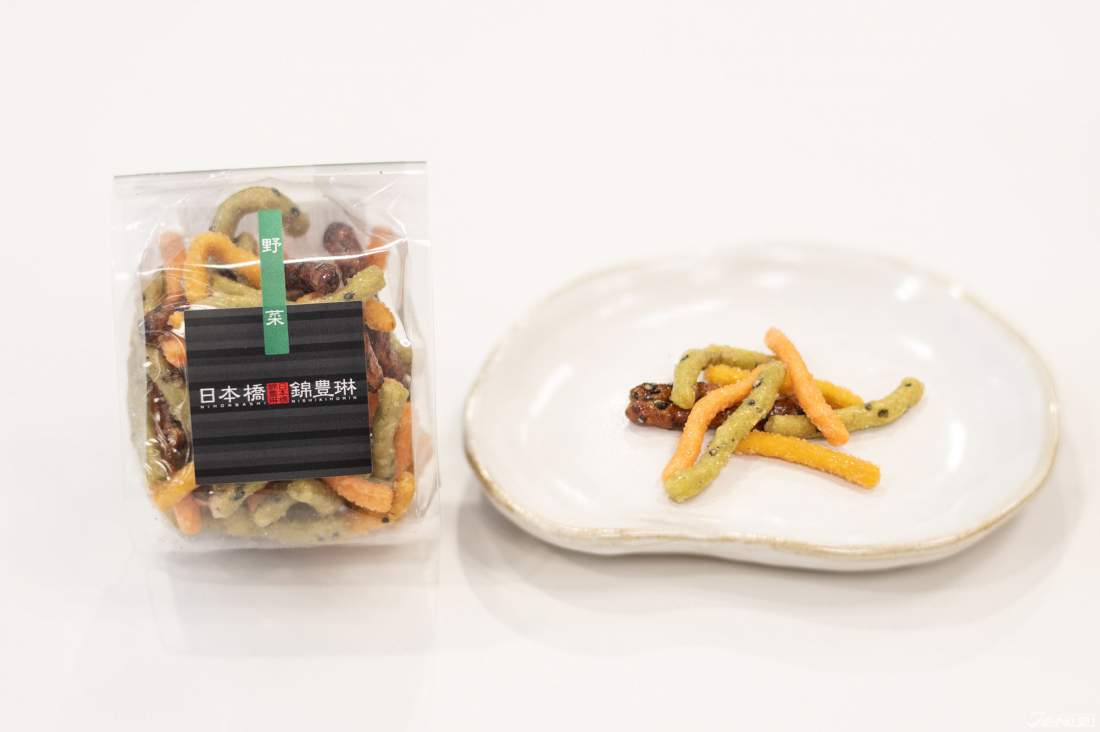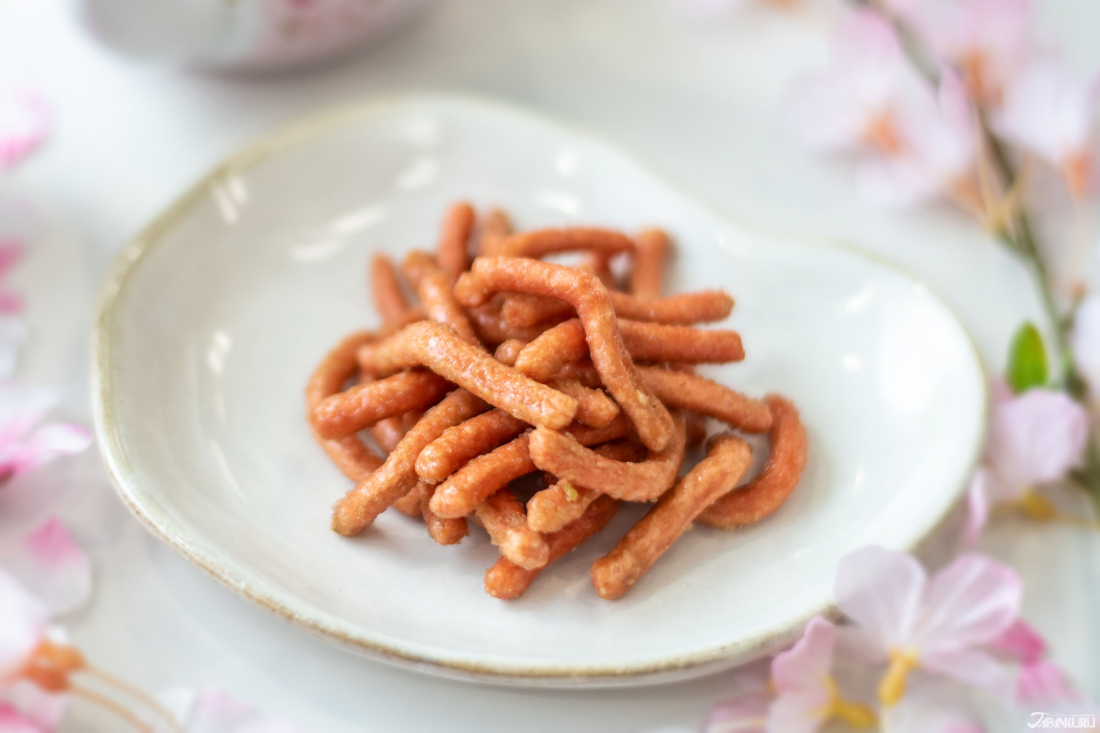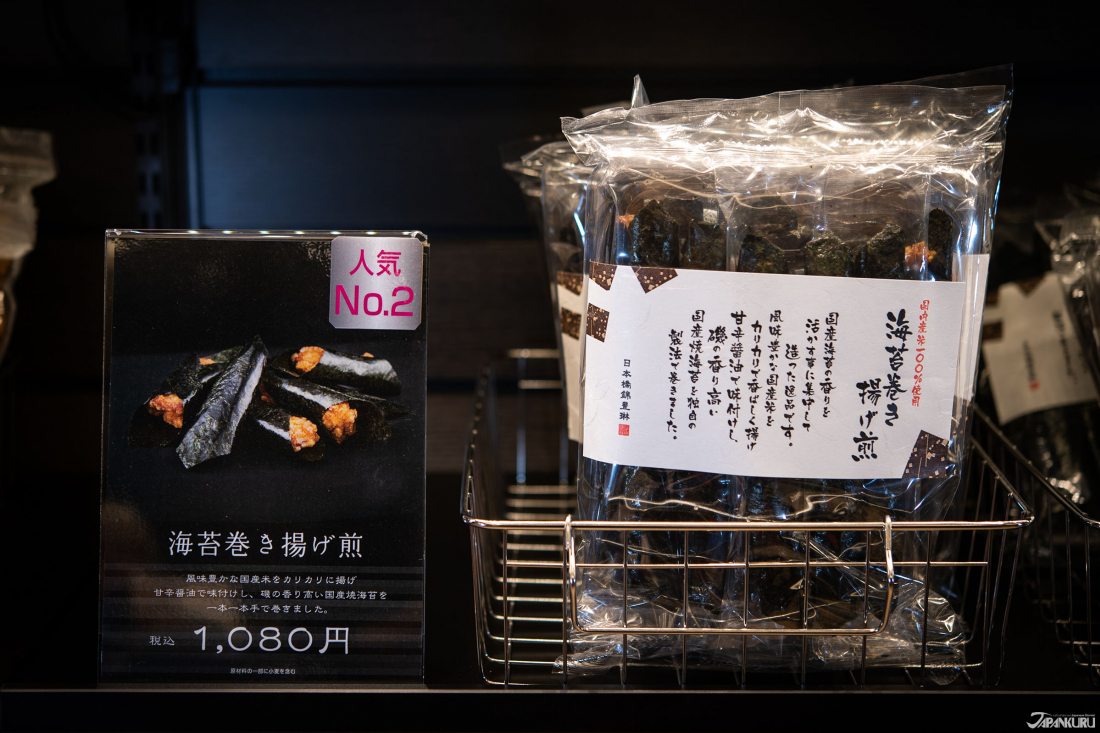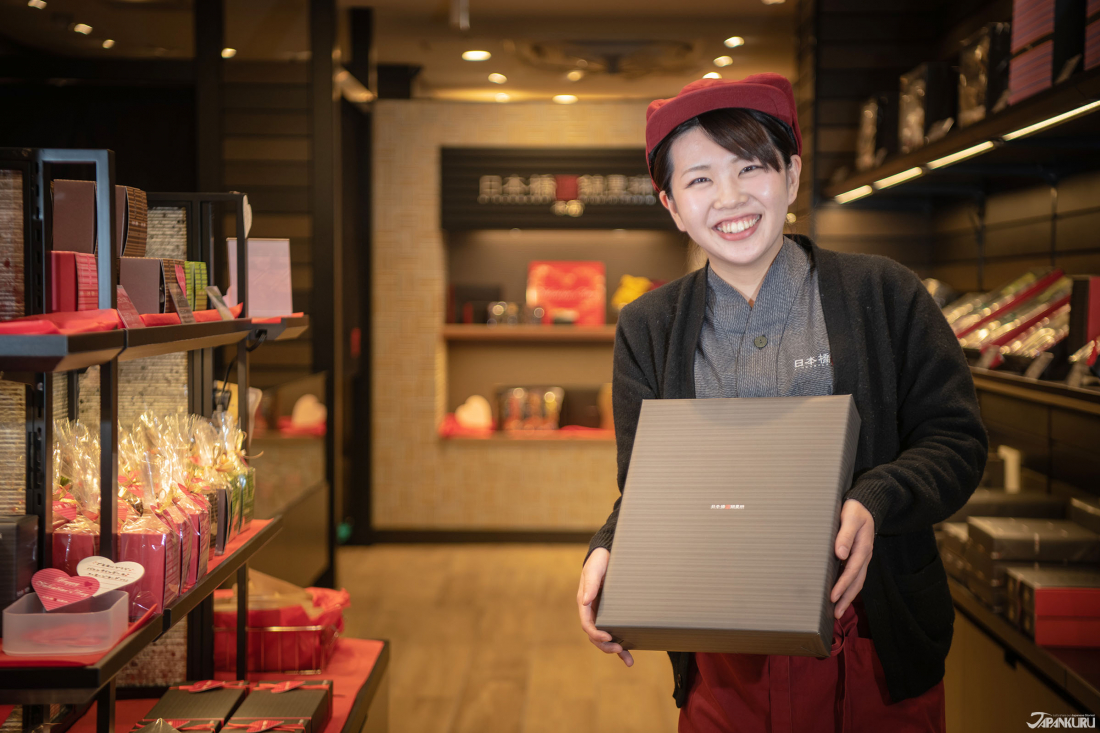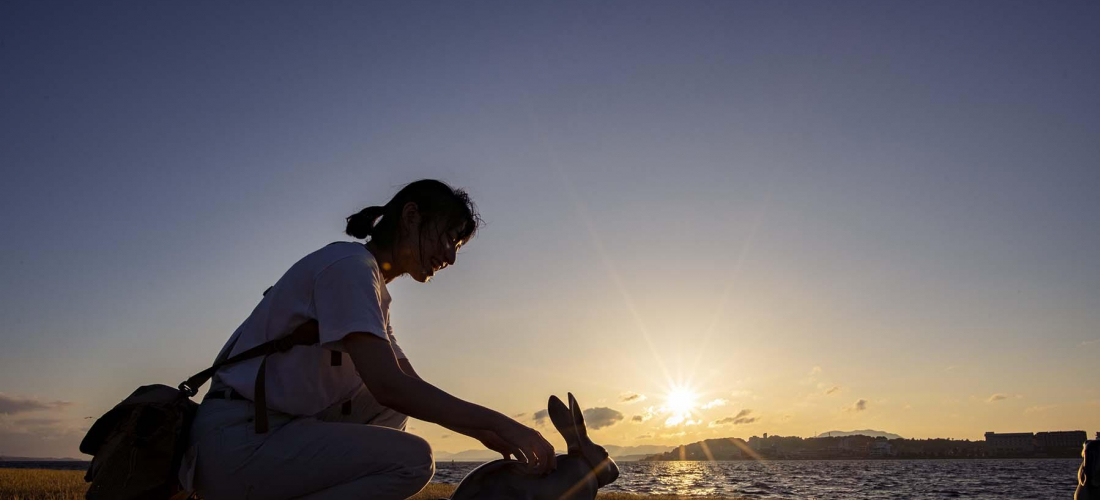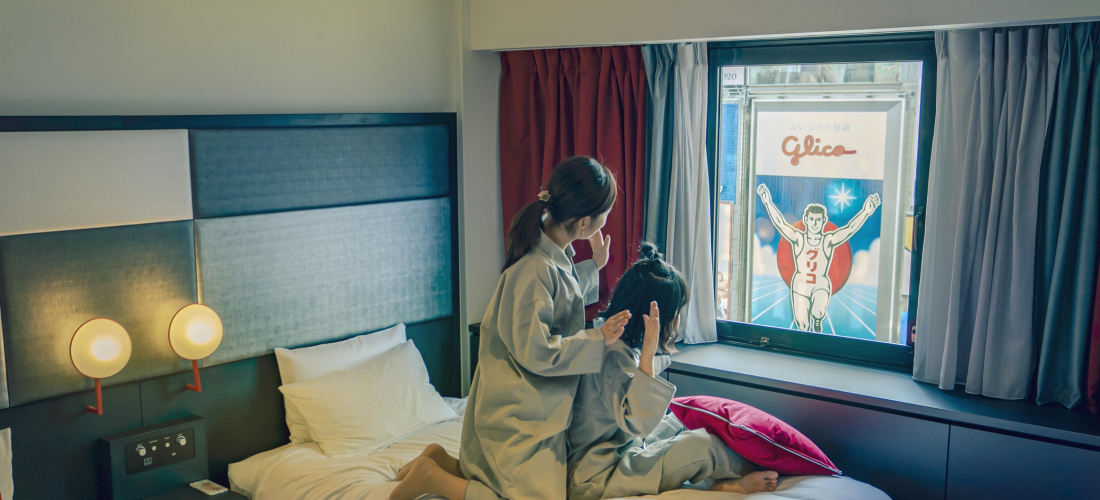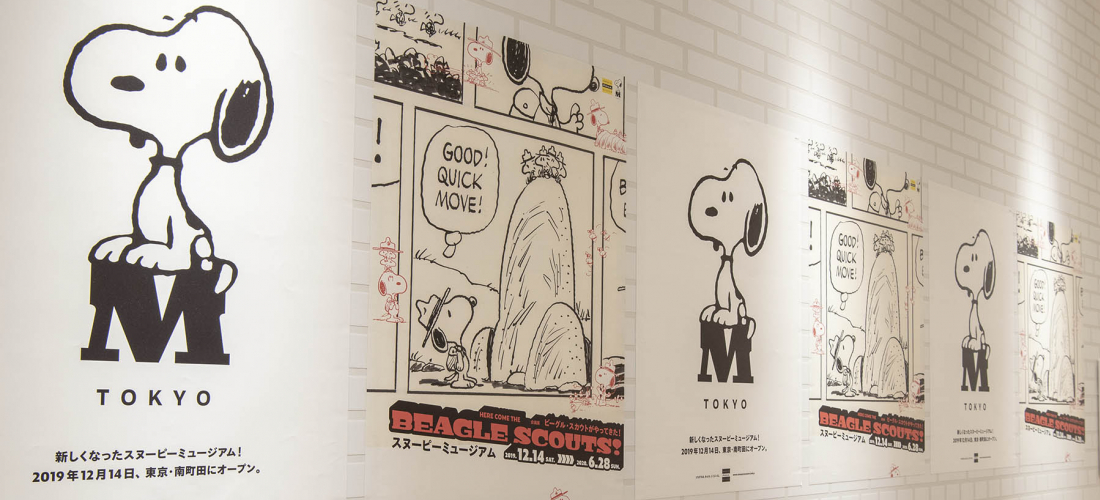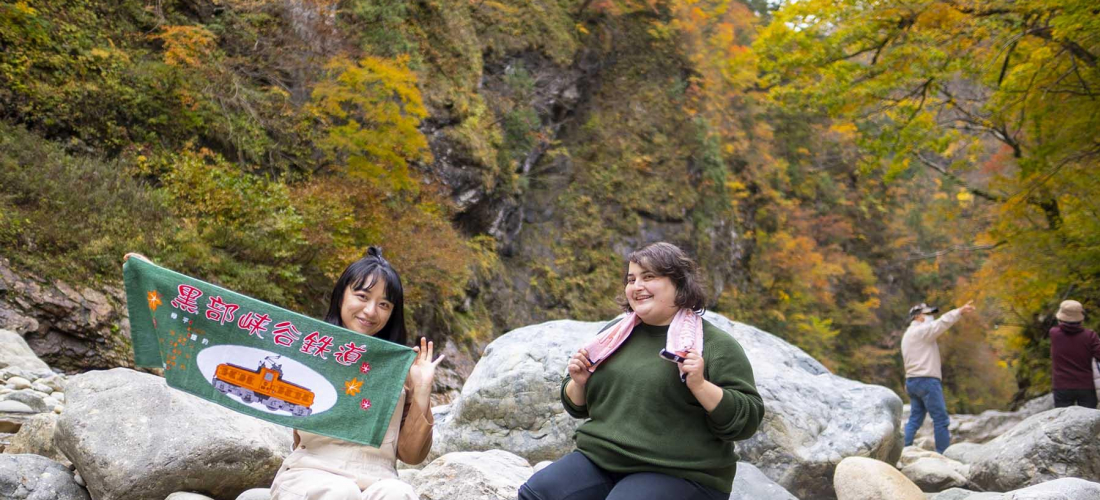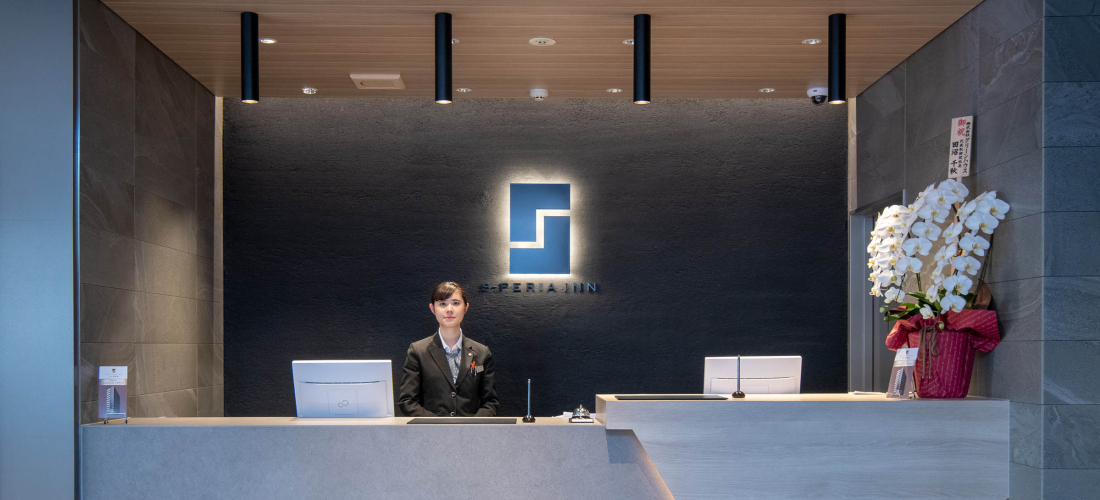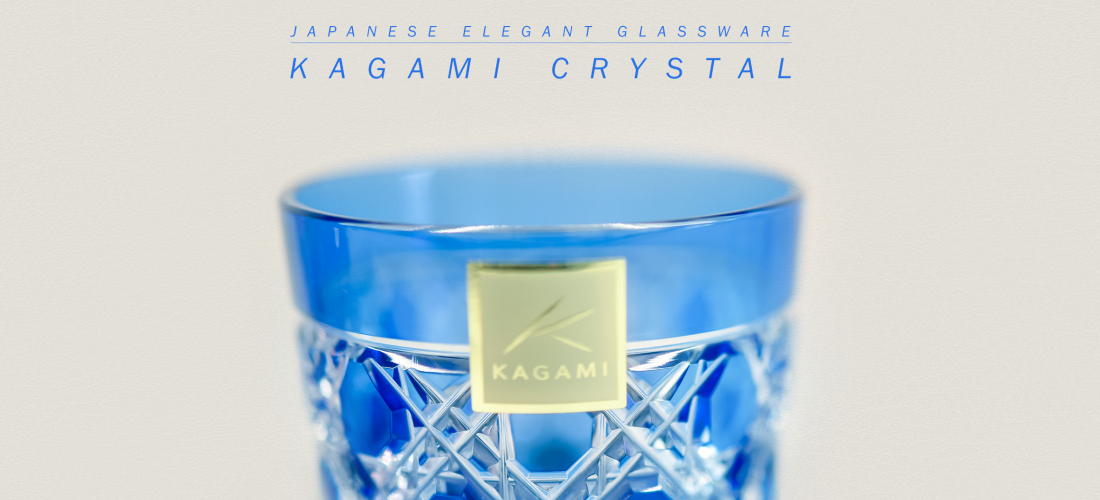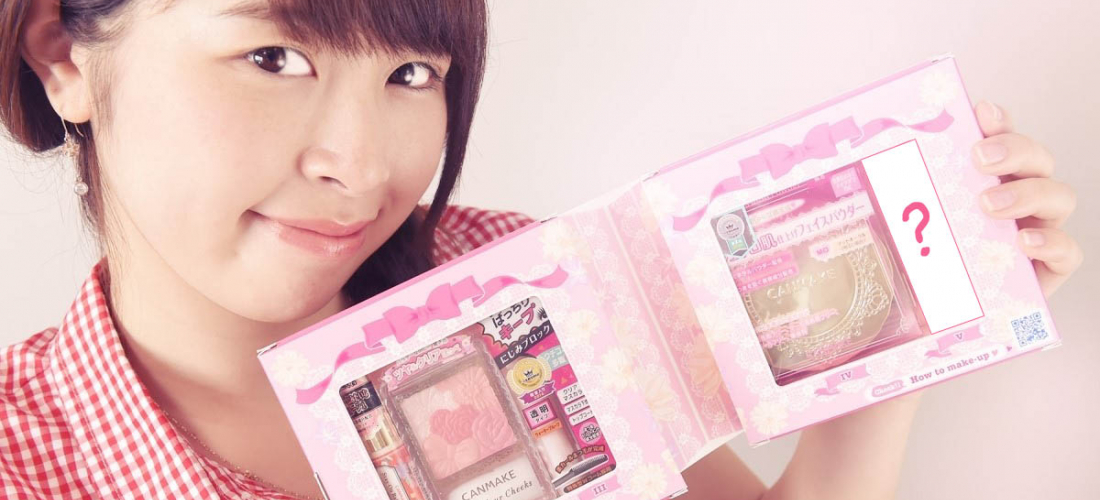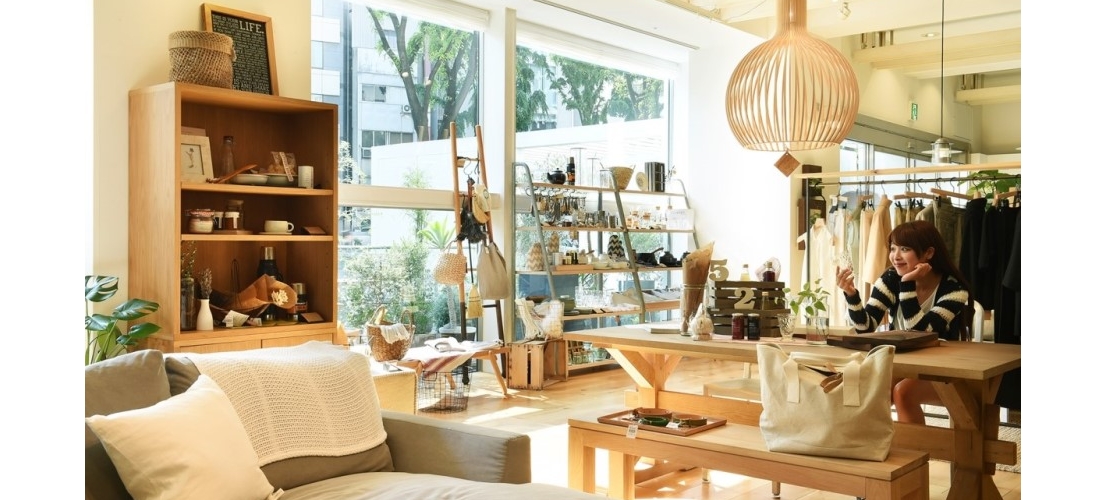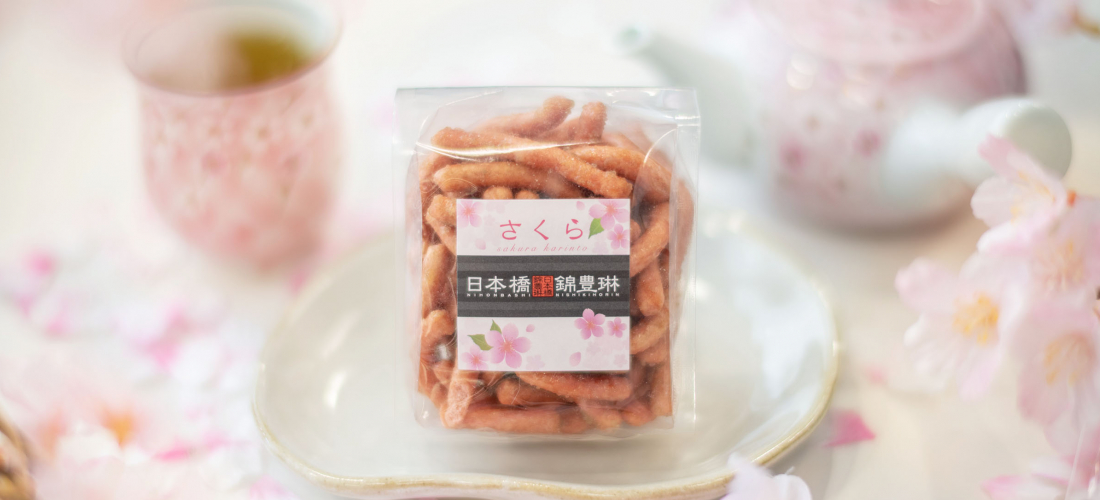
CONTENTS
Les Karinto sont des biscuits traditionnels frits dans l'huile recouverts de sucre brun. On en trouve partout, que ce soit dans les supermarchés ou dans les boutiques diverses tels que Don Quijote, etc. Les biscuits sont si populaires qu'il existe même des enseignes spécialisées. Dans ces dernières vous trouverez toutes sortes de goûts, telles que ceux à la bardane, la patate douce, au chocolat, au sésame ou même à des parfums saisonniers comme le sakura! Comme nous sommes de grands amateurs de biscuits japonais, nous nous sommes rendus à la boutique de Karinto la plus populaire de Tokyo pour découvrir ce qu'ils avaient à nous proposer.
Karinto “Nihonbashi Nishiki Horin” à Nihonbashi (日本橋錦豊琳)
Nihonbashi Nishiki Horin (日本橋錦豊琳), boutique à Nihonbashi
Un magnifique magasin très spacieux comparé à d'autres.
Des karinto soigneusement emballés dans leur papier transparent.
Nihonbashi (日本橋), littéralement "le pont du Japon" est un quartier à Tokyo au nord de Ginza considéré comme le point de départ de toutes les routes de l'archipel. Le fameux pont de Nihonbashi marque le début des routes reliant Tokyo à Kyoto et Osaka et a ainsi créé une culture unique autour du commerce.
Si vous vous êtes promené autour de la gare de Tokyo ou du Tokyo Solamach de la Skytree, vous avez pu apercevoir des boutiques de Nihonbashi Nishiki Horin (日本橋錦豊琳). Plutôt que de vous rendre à la gare de Tokyo et faire la queue, vous pouvez visiter leur boutique située à Nihonbashi qui est bien plus calme. Vous pourrez ainsi poser tranquillement des questions aux vendeurs et vous faire conseiller.
Les karinto japonais vendus à Nihonbashi Nishiki Horin
Les karinto sont des biscuits traditionnels qui existent depuis 700 ans au Japon. Ils sont fait en général avec un mélange de farine de blés, d'eau, de levure et de sucre, donnant au tout une allure assez étrange, il faut bien l'avouer.
Mais les karinto vendus à Nihonbashi Nishiki Horin varient un peu de ce qu'on voit d'habitude car les ingrédients qui font les différents parfums sont directement ajoutés à la pâte plutôt qu'enduits après les avoir frits. Cela permet d'avoir des arômes et une texture mieux équilibrés ensemble.
D'ailleurs, Nihonbashi Nishiki Horin propose 10 arômes différents dans leur karinto. Certains sont plutôt traditionnels, tels que le goût yuzu, sésame, gingembre ou prune. Mais d'autres ont des saveurs très particulières, comme le thé, le café, ou le charbon de bambou. Ci-dessous, les trois types de karinto les plus populaires.
Parfum populaire No. 1: Racines de bardane coupées (きんびらごぼう; Kinpira-gobo)
(きんびらごぼう; Kinpira-gobo) est un type de racine de bardane finement coupée et cuite dans de l'huile assaisonnée de sauce soja. La bardane est très souvent utilisée dans les plats japonais, ce qui explique son utilisation et sa popularité ici.
Parfum populaire No. 2: légumes (野菜; Yasai)v
Les karinto aux légumes sont fabriqués à base de 5 végétaux pétris dans la pâte. Les différentes couleurs rendent les biscuits amusant à manger, sans oublier que les légumes sont cultivés localement et donc bons pour la santé.
Parfum populaire No. 3: Patate douce violette (むらさきいも; Murasaki Imo)
Ces karinto sont idéaux pour ceux qui désirent un goût plutôt doux offert grâce à la patate douce violette (ou Murasaki). Le goût de la patate douce est très présent, ce qui en fait un produit très populaire.
Le Japon est très connu pour ces fameux cerisiers en fleur (sakura), et, une fois arrivé à la saison, vous trouverez toutes sortes de choses vendues avec cette thématique. Nihonbashi Nishiki Horin ne déroge pas à l'appel et propose des karinto au goût sakura.
En vente à partir du 1er mars, les biscuits sont faits à partir des feuilles de sakura afin de garder l'odeur et le goût de l'arbre en fleur. Certains karinto sont mangés à l'apéritif, mais ceux au sakura iront mieux avec une bonne tasse de thé.
Les autres biscuits disponibles
Sauce soja sucrée (甘露醤油; Kanro Shoyu)
Algues frites (海苔巻き揚げ煎; Nori-Maki-Age Ni)
Huile d'olive
Peu d'étrangers sont familiers avec les karinto, ce qui en fait de superbes souvenirs à ramener et à offrir. Surtout si ces derniers viennent d'une des célèbres boutiques de Nihonbashi Nishiki Horin. Vous pouvez goûter les différents types de karinto en magasin puis choisir vos préférés, ou encore acheter des boîtes toutes préparées.
Nihonbashi Nishiki Horin (日本橋錦豊琳)
Google Maps
⏰10:00〜18:30
Fermé les samedi et dimanche
Details
NAME:Nihonbashi Nishiki Horin (日本橋錦豊琳)
MAP
16-14 Nihonbashi Kodenmacho, Chuo, Tokyo
ACCESS:Kodemmachō Station
COMMENT
FEATURED MEDIA
VIEW MORE 
A New Tokyo Animal Destination: Relax & Learn About the World’s Animals in Japan
#pr #japankuru #anitouch #anitouchtokyodome #capybara #capybaracafe #animalcafe #tokyotrip #japantrip #카피바라 #애니터치 #아이와가볼만한곳 #도쿄여행 #가족여행 #東京旅遊 #東京親子景點 #日本動物互動體驗 #水豚泡澡 #東京巨蛋城 #เที่ยวญี่ปุ่น2025 #ที่เที่ยวครอบครัว #สวนสัตว์ในร่ม #TokyoDomeCity #anitouchtokyodome

Shohei Ohtani Collab Developed Products & Other Japanese Drugstore Recommendations From Kowa
#pr #japankuru
#kowa #syncronkowa #japanshopping #preworkout #postworkout #tokyoshopping #japantrip #일본쇼핑 #일본이온음료 #오타니 #오타니쇼헤이 #코와 #興和 #日本必買 #日本旅遊 #運動補充能量 #運動飲品 #ช้อปปิ้งญี่ปุ่น #เครื่องดื่มออกกำลังกาย #นักกีฬา #ผลิตภัณฑ์ญี่ปุ่น #อาหารเสริมญี่ปุ่น

도쿄 근교 당일치기 여행 추천! 작은 에도라 불리는 ‘가와고에’
세이부 ‘가와고에 패스(디지털)’ 하나면 편리하게 이동 + 가성비까지 완벽하게! 필름카메라 감성 가득한 레트로 거리 길거리 먹방부터 귀여움 끝판왕 핫플&포토 스폿까지 총집합!
Looking for day trips from Tokyo? Try Kawagoe, AKA Little Edo!
Use the SEIBU KAWAGOE PASS (Digital) for easy, affordable transportation!
Check out the historic streets of Kawagoe for some great street food and plenty of picturesque retro photo ops.
#pr #japankuru #도쿄근교여행 #가와고에 #가와고에패스 #세이부패스 #기모노체험 #가와고에여행 #도쿄여행코스 #도쿄근교당일치기 #세이부가와고에패스
#tokyotrip #kawagoe #tokyodaytrip #seibukawagoepass #kimono #japantrip

Hirakata Park, Osaka: Enjoy the Classic Japanese Theme Park Experience!
#pr #japankuru #hirakatapark #amusementpark #japantrip #osakatrip #familytrip #rollercoaster #retrôvibes #枚方公園 #大阪旅遊 #關西私房景點 #日本親子旅行 #日本遊樂園 #木造雲霄飛車 #히라카타파크 #สวนสนุกฮิราคาตะพาร์ค

🍵Love Matcha? Upgrade Your Matcha Experience With Tsujiri!
・160년 전통 일본 말차 브랜드 츠지리에서 말차 덕후들이 픽한 인기템만 골라봤어요
・抹茶控的天堂!甜點、餅乾、飲品一次滿足,連伴手禮都幫你列好清單了
・ส่องมัทฉะสุดฮิต พร้อมพาเที่ยวร้านดังในอุจิ เกียวโต
#pr #japankuru #matcha #matchalover #uji #kyoto #japantrip #ujimatcha #matchalatte #matchasweets #tsujiri #말차 #말차덕후 #츠지리 #교토여행 #말차라떼 #辻利抹茶 #抹茶控 #日本抹茶 #宇治 #宇治抹茶 #日本伴手禮 #抹茶拿鐵 #抹茶甜點 #มัทฉะ #ของฝากญี่ปุ่น #ชาเขียวญี่ปุ่น #ซึจิริ #เกียวโต

・What Is Nenaito? And How Does This Sleep Care Supplement Work?
・你的睡眠保健品——認識「睡眠茶氨酸錠」
・수면 케어 서플리먼트 ‘네나이토’란?
・ผลิตภัณฑ์เสริมอาหารดูแลการนอน “Nenaito(ネナイト)” คืออะไร?
#pr #japankuru #sleepcare #japanshopping #nenaito #sleepsupplement #asahi #睡眠茶氨酸錠 #睡眠保健 #朝日 #l茶胺酸 #日本藥妝 #日本必買 #일본쇼핑 #수면 #건강하자 #네나이토 #일본영양제 #อาหารเสริมญี่ปุ่น #ช้อปปิ้งญี่ปุ่น #ร้านขายยาญี่ปุ่น #ดูแลตัวเองก่อนนอน #อาซาฮิ

Japanese Drugstore Must-Buys! Essential Items from Hisamitsu® Pharmaceutical
#PR #japankuru #hisamitsu #salonpas #feitas #hisamitsupharmaceutical #japanshopping #tokyoshopping #traveltips #japanhaul #japantrip #japantravel

Whether you grew up with Dragon Ball or you just fell in love with Dragon Ball DAIMA, you'll like the newest JINS collab. Shop this limited-edition Dragon Ball accessory collection to find some of the best Dragon Ball merchandise in Japan!
>> Find out more at Japankuru.com! (link in bio)
#japankuru #dragonball #dragonballdaima #animecollab #japanshopping #jins #japaneseglasses #japantravel #animemerch #pr

This month, Japankuru teamed up with @official_korekoko to invite three influencers (originally from Thailand, China, and Taiwan) on a trip to Yokohama. Check out the article (in Chinese) on Japankuru.com for all of their travel tips and photography hints - and look forward to more cool collaborations coming soon!
【橫濱夜散策 x 教你怎麼拍出網美照 📸✨】
每次來日本玩,是不是都會先找旅日網紅的推薦清單?
這次,我們邀請擁有日本豐富旅遊經驗的🇹🇭泰國、🇨🇳中國、🇹🇼台灣網紅,帶你走進夜晚的橫濱!從玩樂路線到拍照技巧,教你怎麼拍出最美的夜景照。那些熟悉的景點,換個視角說不定會有新發現~快跟他們一起出發吧!
#japankuru #橫濱紅磚倉庫 #汽車道 #中華街 #yokohama #japankuru #橫濱紅磚倉庫 #汽車道 #中華街 #yokohama #yokohamaredbrickwarehouse #yokohamachinatown

If you’re a fan of Vivienne Westwood's Japanese designs, and you’re looking forward to shopping in Harajuku this summer, we’ve got important news for you. Vivienne Westwood RED LABEL Laforet Harajuku is now closed for renovations - but the grand reopening is scheduled for July!
>> Find out more at Japankuru.com! (link in bio)
#japankuru #viviennewestwood #harajuku #omotesando #viviennewestwoodredlabel #viviennewestwoodjapan #비비안웨스트우드 #오모테산도 #하라주쿠 #日本購物 #薇薇安魏斯伍德 #日本時尚 #原宿 #表參道 #japantrip #japanshopping #pr

Ready to see TeamLab in Kyoto!? At TeamLab Biovortex Kyoto, the collective is taking their acclaimed immersive art and bringing it to Japan's ancient capital. We can't wait to see it for ourselves this autumn!
>> Find out more at Japankuru.com! (link in bio)
#japankuru #teamlab #teamlabbiovortex #kyoto #kyototrip #japantravel #artnews
Photos courtesy of teamLab, Exhibition view of teamLab Biovortex Kyoto, 2025, Kyoto ® teamLab, courtesy Pace Gallery

Japanese Makeup Shopping • A Trip to Kamakura & Enoshima With Canmake’s Cool-Toned Summer Makeup
#pr #canmake #enoshima #enoden #에노시마 #캔메이크 #japanesemakeup #japanesecosmetics

⚔️The Robot Restaurant is gone, but the Samurai Restaurant is here to take its place. Check it out, and don't forget your coupon!
🍣신주쿠의 명소 로봇 레스토랑이 사무라이 레스토랑으로 부활! 절찬 쿠폰 발급중
💃18歲以上才能入場的歌舞秀,和你想的不一樣!拿好優惠券去看看~
#tokyo #shinjuku #samurairestaurant #robotrestaurant #tokyotrip #도쿄여행 #신주쿠 #사무라이레스토랑 #이색체험 #할인이벤트 #歌舞伎町 #東京景點 #武士餐廳 #日本表演 #日本文化體驗 #japankuru #japantrip #japantravel #japanlovers #japan_of_insta

Japanese appliance & electronics shopping with our KOJIMA x BicCamera coupon!
用JAPANKURU的KOJIMA x BicCamera優惠券買這些正好❤️
코지마 x 빅 카메라 쿠폰으로 일본 가전 제품 쇼핑하기
#pr #japankuru #japanshopping #kojima #biccamera #japaneseskincare #yaman #dji #osmopocket3 #skincaredevice #日本購物 #美容儀 #相機 #雅萌 #日本家電 #일본여행 #면세 #여행꿀팁 #일본쇼핑리스트 #쿠폰 #일본쇼핑 #일본브랜드 #할인 #코지마 #빅카메라 #japankurucoupon

